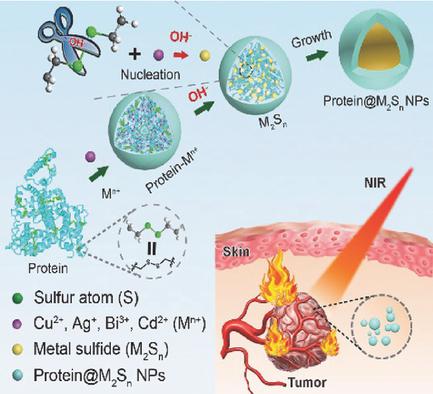Our official English website, www.x-mol.net, welcomes your feedback! (Note: you will need to create a separate account there.)
Dual Roles of Protein as a Template and a Sulfur Provider: A General Approach to Metal Sulfides for Efficient Photothermal Therapy of Cancer
Small ( IF 13.3 ) Pub Date : 2017-11-17 , DOI: 10.1002/smll.201702529 Jianping Sheng 1 , Liqiang Wang 1 , Yajing Han 1 , Wansong Chen 1, 2 , Hong Liu 3 , Min Zhang 4 , Liu Deng 1 , You-Nian Liu 1, 2
Small ( IF 13.3 ) Pub Date : 2017-11-17 , DOI: 10.1002/smll.201702529 Jianping Sheng 1 , Liqiang Wang 1 , Yajing Han 1 , Wansong Chen 1, 2 , Hong Liu 3 , Min Zhang 4 , Liu Deng 1 , You-Nian Liu 1, 2
Affiliation

|
Fabrication of clinically translatable nanoparticles (NPs) as photothermal therapy (PTT) agents against cancer is becoming increasingly desirable, but still challenging, especially in facile and controllable synthesis of biocompatible NPs with high photothermal efficiency. A new strategy which uses protein as both a template and a sulfur provider is proposed for facile, cost‐effective, and large‐scale construction of biocompatible metal sulfide NPs with controlled structure and high photothermal efficiency. Upon mixing proteins and metal ions under alkaline conditions, the metal ions can be rapidly coordinated via a biuret‐reaction like process. In the presence of alkali, the inert disulfide bonds of S‐rich proteins can be activated to react with metal ions and generate metal sulfide NPs under gentle conditions. As a template, the protein can confine and regulate the nucleation and growth of the metal sulfide NPs within the protein formed cavities. Thus, the obtained metal sulfides such as Ag2S, Bi2S3, CdS, and CuS NPs are all with small size and coated with proteins, affording them biocompatible surfaces. As a model material, CuS NPs are evaluated as a PTT agent for cancer treatment. They exhibit high photothermal efficiency, high stability, water solubility, and good biocompatibility, making them an excellent PTT agent against tumors. This work paves a new avenue toward the synthesis of structure‐controlled and biocompatible metal sulfide NPs, which can find wide applications in biomedical fields.
中文翻译:

蛋白质作为模板和硫提供者的双重作用:金属硫化物对癌症的有效光热疗法的一般方法。
制造可临床翻译的纳米粒子(NPs)作为抗癌光热疗法(PTT)试剂的需求日益增长,但仍具有挑战性,尤其是在以高光热效率轻松且可控制地合成生物相容性NPs中。提出了一种使用蛋白质作为模板和硫磺提供者的新策略,以易于控制,具有成本效益的大规模构建具有可控结构和高光热效率的生物相容性金属硫化物纳米颗粒。在碱性条件下混合蛋白质和金属离子后,金属离子可通过类似缩二脲反应的过程快速配位。在碱的存在下,富含S的蛋白质的惰性二硫键可以被活化以与金属离子反应,并在温和的条件下生成金属硫化物NP。作为模板,蛋白质可以限制和调节蛋白质形成腔内金属硫化物NP的成核和生长。因此,获得的金属硫化物如Ag2 S,Bi 2 S 3,CdS和CuS NP都体积小,并被蛋白质包被,为它们提供了生物相容性表面。作为模型材料,CuS NP被评估为用于癌症治疗的PTT剂。它们表现出高的光热效率,高稳定性,水溶性和良好的生物相容性,使其成为抗肿瘤的优良PTT剂。这项工作为结构受控和生物相容性金属硫化物NP的合成开辟了一条新途径,可以在生物医学领域中找到广泛的应用。
更新日期:2017-11-17
中文翻译:

蛋白质作为模板和硫提供者的双重作用:金属硫化物对癌症的有效光热疗法的一般方法。
制造可临床翻译的纳米粒子(NPs)作为抗癌光热疗法(PTT)试剂的需求日益增长,但仍具有挑战性,尤其是在以高光热效率轻松且可控制地合成生物相容性NPs中。提出了一种使用蛋白质作为模板和硫磺提供者的新策略,以易于控制,具有成本效益的大规模构建具有可控结构和高光热效率的生物相容性金属硫化物纳米颗粒。在碱性条件下混合蛋白质和金属离子后,金属离子可通过类似缩二脲反应的过程快速配位。在碱的存在下,富含S的蛋白质的惰性二硫键可以被活化以与金属离子反应,并在温和的条件下生成金属硫化物NP。作为模板,蛋白质可以限制和调节蛋白质形成腔内金属硫化物NP的成核和生长。因此,获得的金属硫化物如Ag2 S,Bi 2 S 3,CdS和CuS NP都体积小,并被蛋白质包被,为它们提供了生物相容性表面。作为模型材料,CuS NP被评估为用于癌症治疗的PTT剂。它们表现出高的光热效率,高稳定性,水溶性和良好的生物相容性,使其成为抗肿瘤的优良PTT剂。这项工作为结构受控和生物相容性金属硫化物NP的合成开辟了一条新途径,可以在生物医学领域中找到广泛的应用。



























 京公网安备 11010802027423号
京公网安备 11010802027423号